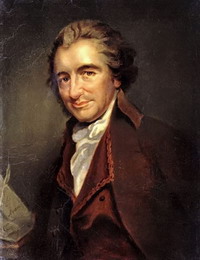Login form
Thomas Paine

Thomas Paine, born in England in 1737, was a poor man with rich ideas about freedom. He believed the American colonies could become a new nation free from Great Britain. One of the great writers of his time, Paine’s writings inspired Americans to revolt against Britain. “The birthday of a new world is at hand,” Paine wrote in his most famous publication, Common Sense.
PAINE COMES TO AMERICA
As a young man, Thomas Paine met American statesman Benjamin Franklin in London. Encouraged by Franklin, Paine sailed for Philadelphia, Pennsylvania, in 1774. Once there, he picked up his pen in the cause of liberty.
In one article he spoke out strongly against the practice of slavery, which was still common in America. Paine believed that people should be free to pursue their own lives.
PAINE PROMOTES AMERICAN INDEPENDENCE
In January 1776, Paine published a 50-page pamphlet called Common Sense. The pamphlet sold over 500,000 copies! Great Britain, he wrote, unfairly used the colonies for money and manpower. Paine branded King George III as a tyrant who squashed American freedoms. Paine boldly called the colonies: “THE FREE AND INDEPENDENT STATES OF AMERICA.”
Paine’s arguments helped many Americans decide to support independence from Great Britain. In July 1776, the Second Continental Congress adopted the Declaration of Independence, in which the colonies officially broke away from Britain. The people of America then began eight long years of war.
During this war, the American Revolution (1775-1783), Paine wrote a series of pamphlets called The American Crisis. During the harsh winter of 1776-1777, he reassured Americans, “These are the times that try men’s souls … but he that stands it now, deserves the love and thanks of man and woman.”
LATER LIFE
Thomas Paine returned to Great Britain in 1787. Five years later, his book Rights of Man got him in trouble for again criticizing monarchies (rule by kings and queens). In 1792, Paine fled to France, a country in the middle of its own revolution (1789-1799). There, he was thrown into prison for nearly a year because he did not support the beheading of King Louis XVI.
Part I of Paine’s book The Age of Reason was published in 1794, during his time in prison. By 1807, when Part III of this book appeared, Paine had moved back to America. But by then he had lost many of his supporters. He died in New York in 1809.
Source: Microsoft ® Encarta

